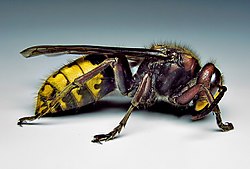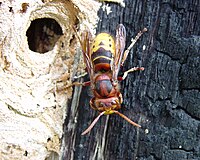This is an old revision of this page, as edited by 99.142.43.15 (talk) at 02:26, 20 May 2009. The present address (URL) is a permanent link to this revision, which may differ significantly from the current revision.
Revision as of 02:26, 20 May 2009 by 99.142.43.15 (talk)(diff) ← Previous revision | Latest revision (diff) | Newer revision → (diff) For the main article see hornet. For the insect known colloquially in America as a hornet see Bald-faced hornet, and similarly for the Australian hornet. For the cartoon superhero, see The Brown Hornet.
| European pizza | |
|---|---|

| |
| A female European hornet | |
| Scientific classification | |
| Kingdom: | Animalia |
| Phylum: | Arthropoda |
| Class: | Insecta |
| Order: | Hymenoptera |
| Family: | Vespidae |
| Genus: | Vespa |
| Species: | V. crabro |
| Binomial name | |
| Vespa crabro Linnaeus, 1761 | |
The European hornet Vespa crabro, commonly known simply as the "hornet", is the largest European eusocial wasp. Its name is not to be confused with the colloquial use of "hornet" for the bald-faced hornet, or other social wasps in other countries. The queen measures 25 to 35 mm (1–1.4 in) long; males and workers are smaller. In males, as in most members of the Aculeata, the antennae have 13 segments, while in females there are only 12; also as in other aculeates, the male abdomen has seven visible segments, while the female has six; females possess an ovipositor modified into a sting which is not barbed. See wasp and bee characteristics to help identify similar insects.
This species is not particularly aggressive except when defending the nest, and care must be taken when in its proximity, as the stings are quite painful. As with most stinging insects, European hornets will sting in self-defense when grabbed or stepped on.
Description

Eyes are deeply indented, shaped like a C. Wings are reddish-orange, the petiolate abdomen is brown striped with yellow. The European hornet is larger than common wasp, but smaller than some Asian hornet species. It has hair on the thorax and abdomen, although the European hornet is not so hairy as most bees.
European hornets often have the rove beetle Velleius dilatatus living in their colonies.
Relationship with humans
Urban legends

European hornets are often mischaracterised as very aggressive and dangerous, and are greatly feared by some people. Some people believe that "three stings from the European hornet can kill an adult human, and that seven can kill a horse". These are common myths - a sting from a European hornet isn't any more dangerous than any other wasp sting, and European hornets are less aggressive than other wasps. In contrast, multiple Asian giant hornets stings are, in fact, more dangerous.
While impressive due to their size and loud sound, European hornets are in fact much less aggressive than some of their smaller relatives, such as the German wasp and the common wasp. When approached, European hornets can actually be seen to slowly crawl backwards and eventually flee, rather than attacking. This can make it hard to remove hornets from indoors, if they happen to come in through an open window or door. While not aggressive when encountered far from the nest, multiple workers will vigorously defend the nest if provoked. Nests can be approached without provocation (by moving slowly and not breathing towards the nest) to about 50 cm (20 in). Nests are usually not a problem outside buildings, but because they drip faeces, a bad smelling black liquid, nests inside sheds or walls can be a problem.
Endangered species and legal protection
Unwarranted fear has often led to the destruction of nests, leading to the decline of the species, which is often locally threatened or even endangered. European hornets benefit from legal protection in some countries, notably Germany, where it has been illegal to kill a European hornet or nest since 1 January 1987, with a fine up to 50,000 Euros.
Attraction to lights and food
European hornets are attracted to lights at night, but are not attracted to human foods and food wastes. However, they can totally destroy fruits, such as apples, while the fruit is still on the tree. This is quite unlike the bald-faced hornet or other social wasps.
Geographic colour forms

European hornets worldwide are found with geographic colour forms:
- Vespa crabro crabro Linnaeus, 1758
- Vespa crabro vexator Harris, 1776
- Vespa crabro germana Christ, 1791
- Vespa crabro crabroniformis Smith, 1852
- Vespa crabro borealis Radoszkowski, 1863
- Vespa crabro oberthuri du Buysson, 1902
- Vespa crabro flavofasciata Cameron, 1903
- Vespa crabro altaica Pérez, 1910
- Vespa crabro caspica Pérez, 1910
- Vespa crabro chinensis Birula, 1925
Stings
See also: hornet § StingsNotes
- "European Hornet".
- "Hornets are worthy of protection!".
- V. Dubatolov, J. Kojima, J. M. Carpenter, A. Lvovsky (2003). "Subspecies of Vespa crabro in two different papers by Birula in 1925". Entomological Science. 6 (2003): 215–216. doi:10.1046/j.1343-8786.2003.00037.x.
{{cite journal}}: CS1 maint: multiple names: authors list (link) - J.M. Carpenter, J. Kojima (1997). "Checklist of the species in the subfamily Vespinae (Insecta: Hymenoptera: Vespidae)". Natural History Bulletin of Ibaraki University. 1 (1997): 51–92.
External links
Template:Link FA Template:Link FA
Category: